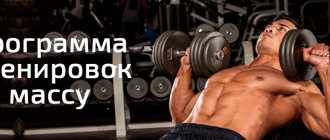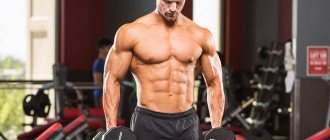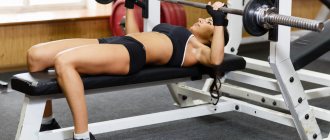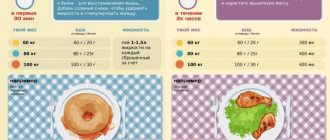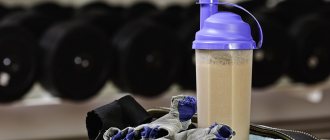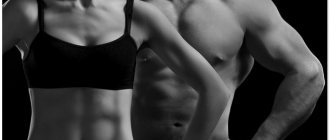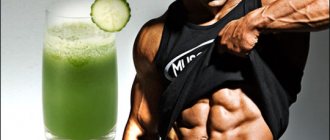For a long time, there was an opinion that muscle growth is due solely to its destruction during training and recovery after. Actually this is not true.
Hyperplasia is a popular, but not the only technique that allows you to achieve weight gain. In the initial stages of training, while the nervous system is under stress and untrained muscle fibers differ from each other in length and recovery rate, microtraumas really help the body “grow”.
Over time, the body adapts to the stress. Once the fibers are aligned along their length, they stop tearing and athletes require other factors to achieve progress.
Which ones exactly? Read more about how muscles grow after training in beginners and experienced athletes in this article!
Mechanism of muscle growth
Muscles are a set of long fibers consisting of cells - myotubes, which promote their contraction and satellite cells, which ensure regeneration.
The growth of muscle mass is responsible for the processes of hypertrophy and hyperplasia, which are triggered in the body during exercise and rest after training under the influence of certain factors.
The main “building materials” for launching these processes are a set of components entering the blood: free creatine, hydrogen ions, anabolic hormones, amino acids, etc.
Skeletal Muscle and Muscle Growth - Key Points
Today we will look at the basic mechanisms and principles of growth of skeletal muscles, which consist of thread-like myofibrils, in turn consisting of sarcomeres (their composition is represented by myosin and actin protein filaments - filaments).
About 650 skeletal muscles in the human body contract when they receive signals from motor neurons that cause the muscles to contract. And the better these contraction signals, the more strength we are able to develop.
If a person is able to lift a very heavy load even though he does not look very muscular, this means that his motor neurons are activated quite strongly and cause stronger muscle contractions. Therefore, powerlifters can look less toned than bodybuilders, but be stronger. Most of the initial strength gains occur during the initial stages of strength training. Muscle growth stabilizes after this period as muscle activation occurs more easily.
Below we will look at:
- physiology of muscle growth;
- mechanisms of activation of muscle growth;
- the influence of hormones on muscle growth;
- the effect of rest on muscle growth;
- Why rapid muscle growth is unlikely.
How muscles grow after training for beginners
From the beginning of the training process until the personal genetic limit is reached, the process of hypertrophy gain - muscle growth due to an increase in the size of the individual cells and fibers that make them up.
The determining factors that trigger hypertrophy are muscle stimulation during exercise and full recovery during rest.
During training, due to the stress received by the central nervous system, creatine and hydrogen ions enter the blood, which contribute to the launch of the “supercompensation” effect (overgrowth of microtraumas with some “reserve”). During rest, amino acids are produced and a basic restorative background is created for the growth of glycolytic (fast) fibers.
Training style, in turn, determines the type of hypertrophy
, which, according to international classifications,
can be myofibrillar or sarcoplasmic
.
Read also: Mass program
Myofibrillar hypertrophy
A type of hypertrophy that causes a significant increase in muscle tissue density and strength due to an increase in the number of myofibrils.
Myofibrillar hypertrophy can be achieved by alternating high-intensity strength and endurance training, most often used in CrossFit and powerlifting.
Strength training : working weight from 80% of the one-set maximum, the number of repetitions of the selected movement is no more than 5, rest between sets is up to 5 minutes.
Endurance training : working weight no more than 50% of the one-set maximum, number of repetitions of the selected movement from 30 or more, until the muscles burn, rest between approaches no longer than 40 seconds.
Sarcoplasmic hypertrophy
A type of hypertrophy that causes an increase in the size of individual cells without an increase in their strength due to an increase in the volume of sarcoplasm (the non-contractile part of the muscle).
Medium-intensive muscle mass training, most often used by fans of classic and beach bodybuilding, allows you to achieve sarcoplasmic hypertrophy.
Training for mass gain : working weight 60-75% of one-set maximum, number of repetitions of the selected movement from 10 to 15, rest between sets for about 1 minute.
Why is rest necessary for muscle growth?
If you do not provide the body with proper rest or nutrition, you can reverse the anabolic process and put the body into a catabolic state (a state of destruction). Muscle protein metabolism responds to strength training within 24-48 hours after exercise. Thus, the interaction between protein metabolism and food consumed during this period determines the effect of nutrition on muscle hypertrophy.
Age, gender and genetic predisposition are factors affecting the growth of muscle tissue.
It is important to understand that the degree of muscle growth depends on a person's age, gender and genetic predisposition. For example, the male body contains more testosterone than the female body, which allows men to build larger and stronger muscles.
How muscles grow after training among professionals
Experienced athletes who have reached their genetic limit (maximum fiber density and mass) often resort to the hyperplasia technique.
Hyperplasia is a controlled increase in a fixed number of muscle fibers “above” what nature intended. One of the most difficult to reproduce, controversial, not fully studied and, rather, experimental technique, to achieve which it is necessary to spend about nine to ten months or more.
It consists of creating conditions for full cell division - tearing off part of the nucleus by overgrown tissues and creating a separate functional structure from them.
The determining factor that triggers hyperplasia is an excessively high anabolic background, which is unusual for the human body, which can be achieved by training using additional stimulants - sports nutrition and sports pharmacology.
The training is aimed at creating collapse through daily extreme loads with an emphasis on pumping.
Pumping is a high-intensity training complex with a large number of negative repetitions and short rest between approaches, during which more blood enters the muscles than they have time to pump out.
A set of anabolic steroids, peptide hormones, growth hormones and digestive enzymes in various combinations is used as additional stimulants.
What happens to muscles during training. Why shock your muscles during exercise?
Only if you work out in the gym, you have probably already heard that muscles need to be surprised from time to time with an unusual load for them. Muscle shocking is a method of resistance training that involves regularly changing your training program to avoid plateauing. Stagnation or plateau is a period when your muscles are used to doing the same work and stop responding to training.
Although muscle shocking has become a craze among professional fitness trainers and bodybuilders, the concept is by no means new. This is a long-known principle that can be applied to any activity aimed at promoting health and achieving good physical shape. The human body is very cleverly designed and is able to adapt to the load placed on it. When your body adapts to a stimulus, you stop noticing results, be it increased muscle size, weight loss, strength or speed. It is especially important to avoid plateauing if you are trying to gain muscle mass. This is why muscle shocking is a particularly popular method for people who lift weights. Let's look at the different ways you can shock your muscles and encourage them to grow every workout. Options for shocking muscles. Number of approaches. Varying the number of sets of a particular exercise helps vary the degree of muscle fatigue in a workout. Reducing the number of sets by 1-2 in each subsequent exercise helps you provide your muscles with active rest or perform more exercises per training session while maintaining the total number of Sets. And incorporating additional Sets into an exercise helps improve muscle endurance and strength. Number of repetitions. You can achieve similar effects by changing the number of repetitions in the approach. Higher reps with lower weights help improve endurance and burn more calories, while higher weights and lower reps have an effect on strength gains. Duration of rest. In this case, we mean rest between approaches or exercises. A longer rest allows you to invest as much as possible into the next Set or exercise, while a shorter rest increases the intensity of the training and allows you to work hard in less time. Sequence of exercises. It's easy to get used to doing the same workout routine, but one of the simplest and most basic ways to shock your muscles is to change the sequence of exercises. Try starting the workout from the end or simply switching the exercises, you will immediately notice the difference and a completely different effect from your training. Choice of exercises. It is very important that you do not perform the same exercises every workout. You should have at least two training program options with different exercises. Alternate them regularly.
“Building materials” for muscle growth after training
To summarize the above, let us dwell in more detail on the “building materials” that stimulate each of the described processes: free creatine, hydrogen ions, anabolic steroids, peptide hormones, growth hormones and digestive enzymes.
- Free creatine and hydrogen ions are substances that are produced by the body itself and enter the bloodstream as a result of stress resulting from stress in the central nervous system. Stimulates muscle growth during recovery after training.
- Anabolic steroids are supplements that stimulate controlled protein synthesis and its subsequent distribution in muscle tissue during regeneration. They are responsible for the process of primary muscle hypertrophy when used in its pure form and their collapse state when used in combination with growth hormones.
- Peptide hormones are pharmacological agents that promote local hypertrophy of muscle tissue without changing its structure and functionality.
- Growth hormones are pharmacological agents that make it possible to increase the barrier between a cell and its nucleus up to 20 times to achieve collapse.
- Digestive enzymes are supplements that help improve the absorption of protein and proteins needed for muscle growth.
Hypertrophy of muscle fibers
If during a strength or cardio workout you do all the exercises with maximum tension (heavy weight, many repetitions, fast pace), then by the end of the workout a feeling of heat appears in the muscles.
This is the so-called metabolic stress, or pumping, when the muscles are pumped with blood and swelling occurs around the muscle cells.
Because of it, the cells and connective tissue swell, the muscle seems to burst, and its volume increases as a result (however, it does not become stronger).
However, hypertrophy of muscle fibers after training will not last long, usually for several tens of minutes.
Article on the topic: “Leg press in the simulator”
Bodybuilders use pumping before competitions to visually make their muscles more voluminous and prominent and look more impressive in photos and videos.
If the muscles don't grow
In conclusion, here are some simple tips for those who are experiencing muscle growth arrest:
- Limit your energy expenditure while gaining weight. Between workouts, the body should be in a state of relative rest. Recover and grow.
- Carefully plan your training program and the amount of rest in between. Both too infrequent and too frequent exercises with short intervals between them can have a negative effect.
- Don't ignore training individual muscle groups. Especially the legs and back. The largest muscles are located on the legs and back, setting the tone for all the others.
- Adjust your diet. Gaining muscle mass is impossible not only without training and recovery, but also without “building materials” that help them grow.
Author: Full-Fit


